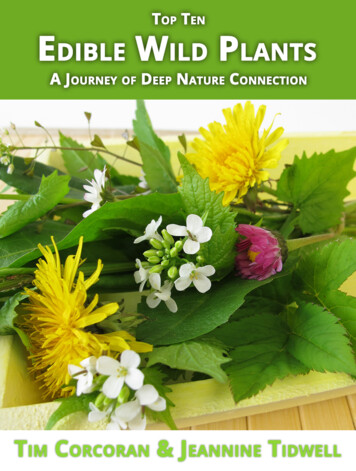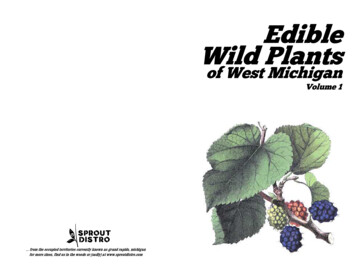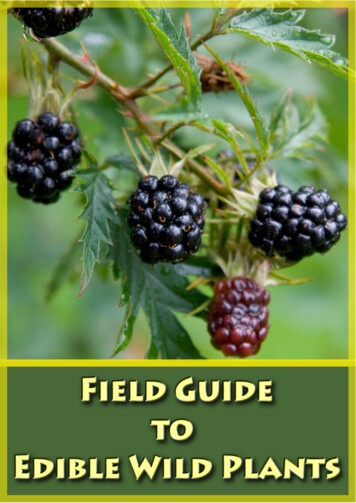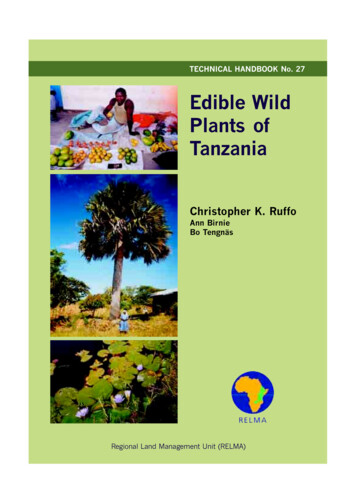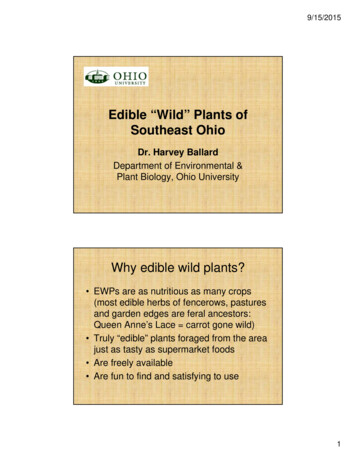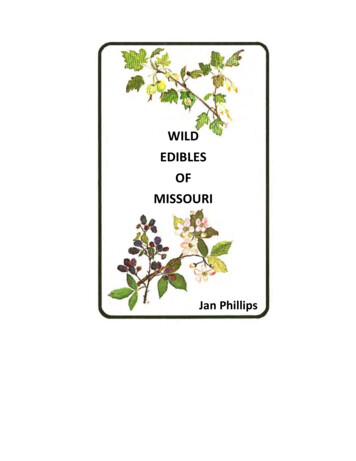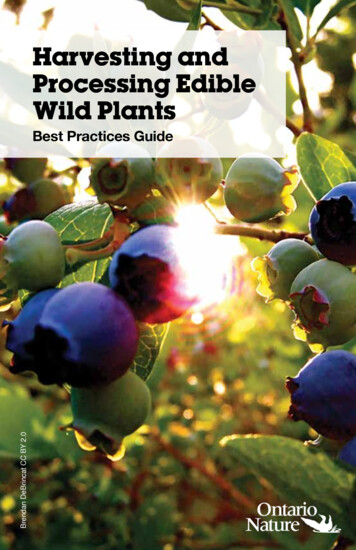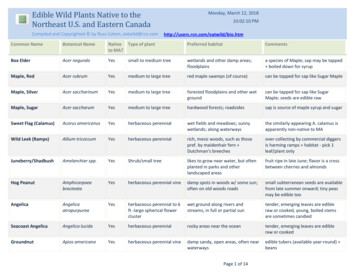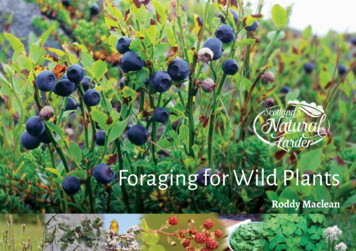
Transcription
Foraging for Wild PlantsRoddy Maclean
Here are some of the plants that can be gathered and eaten inScotland. You must be 100% certain of your plant identification inorder to avoid any poisonous plants which look similar. Make surethat you gather plants in a way that is mindful, responsible andcompletely sustainable. There is guidance for responsible foragingat the end.This publication was originally written in Gaelic and developed in partnership withBòrd na Gàidhlig as part of the Gaelic Foraging Project in which the rich language andculture of the Gaels and close links with nature areexplored.Scotland’s Natural LarderF O R A G I N G F O R W I L D P L A N TS 1
Forest and FieldDandelionBirchEnglish StonecropWatercressUseUseUseUseTea or beer can be made fromthe leaves or roots. The roots(sliced) are good boiled andthen fried for use in salads orstir fries (or raw in salads). Theroasted roots can be mashedand made into a drink similarto coffee (which is caffeinefree).Birch sap is a natural springtonic and syrup can be madefrom it. The leaves can be usedto give a wintergreen taste tovegetables.The leaves can be eaten rawor boiled. They have a slightlypeppery taste.Use older leaves which have aslightly ‘hot’ taste. Boil and useas a vegetable.Health and other usesHealth and other usesDon’t eat too much of it raw asit contains alkaloids that cancause drowsiness or stomachpain.Contains high levels of vitaminC. Avoid picking watercressnear livestock and standingwater due to the danger offluke.Beàrnan BrìdeHealth and other usesDandelion is a good source ofiron, calcium and vitamin A.2 F O R A G I N G F O R W I L D P L A N TSBeithHealth and other usesThe sap is only available for afew weeks of the year and iscollected by drilling into thetrunk.Scotland’s Natural LarderBiadh an t-SionnaidhBiolair Uisge
Wild GarlicCreamhHazelColtsfootPignutUseUseUseThe nuts are delicious roastedand can be used for desserts,cakes and sweets.Some people eat the leaves andflowers - but avoid eating toomany – and a tea can also bemade from the flowers. Theleaves appear after the flowershave gone.The tubers, found by carefullyfollowing the thin undergroundstalk, are very tasty. They canbe eaten raw and have a ‘nutty’taste.Health and other usesPignut can be abundant in oldgrassland, but don’t harvest toomany.CalltainnHealth and other usesHazel nuts are a good sourceof vitamins B & E, K, Calcium,Magnesium. Hazel nuts areknown as ‘Cnò an Eòlais’ or the‘Nut of Knowledge’ in Gaelicfolklore.RowanCaorannUseRowan jelly is made from theberries in autumn – which addsa great taste to meat.Health and other usesHigh in vitamin C and fibre,and also an anti-oxidant. Donot eat the berries raw.Cluas LiathColtsfoot is a plant that haslong been cultivated for itsmedicinal properties andit’s often found in herbalpreparations aimed at treatingrespiratory infections andsore throats. However, it’salso controversial, as researchhas linked some of its keycomponents to liver damage,blood clots, and even cancer.Cnò-thalmhainnHealth and other usesCow ParsleyCostag FhiadhainUseThe leaves may be used as analternative to parsley – theyare good with fish. But note cow parsley sometimes growsbeside hemlock which looksvery similar and is deadlypoisonous. Familiarity withthe carrot family in general(umbellifers) is essential.Scotland’s Natural LarderF O R A G I N G F O R W I L D P L A N TS 3
MeadowsweetCrios Chù Chulainntaste and an appearancesimilar to spinach.Health and other usesTraditionally used by the Gaelsas a healing poultice.Common NettleHealth and other usesCow parsley is common exceptin the northern Highlands,Lewis and Harris. The Gaelicname ‘costag fhiadhain’ means‘wild chervil’.Wild Garlic,RamsonsCreamhUseThe leaves of wild garlic appearin spring and may be used asan alternative to spring onionsor garlic and make great pesto.Lightly pickled, the unopened4 F O R A G I N G F O R W I L D P L A N TSflowers can be kept for agesand go well in salads or withcheese.Health and other usesDon’t eat the bulbs - leavethem in the ground; they aren’tparticularly tasty anyway.MeadowsweetCrios Chù ChulainnUseAppears in April and flowersin June and July. The abundantflowers are good for addingflavour to sweet foods andmake a delicious cordial. TheScotland’s Natural Larderyoung leaves can be used as asalad vegetable (although theflavour is not to everyone’sliking).Health and other usesThe Gaelic name is connectedto the great Gaelic warrior, CùChulainn.Greater PlantainCuach PhàdraigUseThe youngest leaves can beused in salads but the leavesare better boiled with the veinsremoved - it has a mushroomyDeanntagUseYoung leaves make an excellentsoup and can be used wheneveryou would use young spinach.Harvest the youngest leavesfrom the top of the plant inspring and autumn. Regulartrimming encourages a freshsupply of new growth. Boilor steam - which removes thestinging hairs.Health and other usesNettles are a good source ofprotein, Calcium and otherminerals, vitamin C and betacarotene. Avoid during summer.
Brambleberries that follow are good formaking wine, jam and chutneyand vinegar.Wood SorrelBrambles are among thebest foraged food that can begathered and make deliciouspuddings and jams. Tea canalso be made from the leaves.Health and other usesHealth and other usesBeechThe leaves have a sharptaste and are good in salads,dressings and sweets. It’slemony taste goes very wellwith fish. The flowers are alsotasty in salads.DrisUseBeware of the thorns! Knownin Gaelic folklore as ‘an drisbheannaichte’ - ‘the blessedbriar’.ElderDromanUseThe cream coloured flowers ofthe elder tree can be gatheredbetween May and July. A sweettasting cordial or champagnecan be made. The flowersare really good also as a light,starter snack when fried intempura batter. The deep redDon’t gather too many flowersas there will be no berries in theautumn!FaidhbhileFeada CoilleUseHealth and other usesGood source of vitamin C andbeta-carotene. Don’t tear offthe whole plant. Don’t eat toomuch as it contains oxalic acid.ChickweedFliodhUseThe young leaves are good insalads and used in a similarway to spinach.HeatherFraochUseThe young leaves can be eaten(before they have properlyopened, when they are brightgreen) and are good withasparagus or in a salad. Analcoholic drink can be madefrom them too. Oil can beextracted from the masts orfruits.Health and other usesBeech was not native to theHighlands and therefore fewtraditional uses are to be foundin Gaelic culture.Scotland’s Natural LarderF O R A G I N G F O R W I L D P L A N TS 5
Ribwort PlantainSlàn-lusHealth and other usesThis tree is not native toScotland - it therefore is littlementioned in Gaelic culture.ElmLeamhanUseHealth and other usesRich in Magnesium,Phosphorous, Copper, vitaminsC, B6, B12, D & A.HeatherFraochUseTea is made from the flowers(mixed with flowers of otherplants). Beer or ale is also madefrom the flowers.Heather was also used forthatching and in mattresses.Cross-leaved Heath is usefulfor scouring pots.Douglas FirGiuthas MhicDhùghlaisUseThe young needles are soft andedible and can be used to makea tea (rich in vitamin C) or as aflavouring in baking.Health and other uses6 F O R A G I N G F O R W I L D P L A N TSScotland’s Natural LarderThe young seeds can be eatenbefore they dry out. They areslightly sweet and good insalads.Health and other usesElm seeds are particularlynutritious, containing up to45% crude protein.LarchLearagUseAn alcoholic drink (similar tovodka) can be made from thefresh young tips in spring?Health and other usesThis tree is not native toScotland - it therefore is littlementioned in Gaelic culture.Lady’s BedstrawLus an LeasaichUseThe roots are useful for dyeing(red) and a tea is made fromthe flowers. The plant is alsoused to curdle milk;Health and other usesCalled ‘Rù’ in Uist and not to befound in Lewis and the extremenorth of the mainland.
YarrowBlaeberryWood AvensMintUseUseUseUseThe leaves are used in saladsand for making a tea. Good insauces, particularly with fish.Exceptionally good flavourfrom the berries. They may beeaten raw and used to flavourdrinks.The leaves are good in soupsand stews. Use the roots (rawor dried) as an alternative tocloves.Many uses. The leaves are goodin condiments, salads andsweets, and also to make tea.Health and other usesHealth and other usesHigh in anti-oxidants.Found at forest edges androadsides. Not present in theWestern Isles.If it is gathered near sheeppasture, boil the leaves well.Lus Chasgadh na FalaHealth and other usesYarrow was used in theHighlands to clot blood.Wild AngelicaLus nam BuadhUseThe stalks are tasty whensugared and good in cakes; theymay be used instead of celery insauces. The leaves add flavourto salad and cheese sauce.Health and other usesUnmistakeable when theflowers appear in July.Lus nan DearcOpposite-leavedGolden SaxifrageMachall CoilleMeanntHealth and other usesElderDromanLus nan Laogh)UseHas a pleasant enough tastealthough slightly bitter. Theleaves are good in salads inspring and can also be cooked.Health and other usesSometimes to be found inmarshy areas and at springs make sure you don’t tramplethe surrounding environmentwhen collecting.Scotland’s Natural LarderF O R A G I N G F O R W I L D P L A N TS 7
Dog RosePreas nam MucagHealth and other usesHigh in vitamin C. The hips canstill be gathered in winter.searbh ri sùgh nam buinteagan’- ‘as bitter as the juice ofSheep’s Sorrel’.Health and other usesSweet CicelyMirrHogweedOdharanUseUseHas a distinctive aroma andtaste similar to aniseed.Identify your hogweed areaand visit it year after year.Use the leaves in salads andwith fish; also to add flavourto drinks such as vodka.Sweet cicely sometimes growsbeside hemlock which looksvery similar and is deadlypoisonous. Once again,familiarity with the carrotfamily in general (umbellifers)is essential.Fry the very young shoots inbutter. Use the dried seeds as aspice instead of cardamom.Health and other usesHealth and other usesBe careful to avoid GiantHogweed.RoidDog RosePreas nam MucagSyrup is made from the rosehips. The petals are good insalads and sweets.Scotland’s Natural LarderHigh in vitamin C. Also highin oxalic acid, so don’t eat toomuch of it.UseThe leaves are used to flavourbeer and other drinks. Good forroasting with chicken.White CloverHealth and other usesUseWill keep midges at bay!Common SorrelSamhUseUse8 F O R A G I N G F O R W I L D P L A N TSBog MyrtleThe leaves have a bitter taste;can be used in recipes as asubstitute for vinegar or lemon.Good with fish and in Frenchcuisine, also in salads andcooked. Sheep’s Sorrel is usedin almost the same way. Thereis a saying in South Uist - ‘choSeamrag BhànUse the flowers in bread, soupand stew. They will add apea-like taste to salads. Leavescan be used in salads andcondiments too.Health and other usesLeaves are high in protein,Calcium, Magnesium andthiamine.
Red CloverHawthornPrimroseLimeUseUseUseUse(See White Clover).Young buds and fresh leavescan be eaten in spring – whenthey ‘harden and go shiny, theyare less palatable. The flowersare good in salads (when pickedyoung) and with rabbit.The leaves are good in saladsor condiments and are sweettasting. The flowers can beused in salads, with roastedmeat or can be sweetened withsugar and wine can also bemade from the flowers.The buds and fresh leaves aretasty when eaten raw and teacan be made from the flowers.Seamrag DheargHealth and other usesLeaves are high in protein,Calcium, Magnesium andthiamine.Hairy BittercressSearbh-bhiolar GhiobachUseThe leaves have a strong, bitter,peppery taste and can be usedin salads and to make pesto.Health and other usesHigh in vitamins A & C andCalcium, Phosphorous andMagnesium.SgitheachThe haw berries are goodfor making jelly that goesdeliciously with meat.Health and other usesThe haws, flowers and leaves aregood for the heart and the hawsare a good source of vitamin C.SòbhragTeileHealth and other usesSome say that the tea is goodfor the heart and for digestion.Health and other usesPick from an area that is‘speckled’ with primroses andtake care not to tear out theroots.Wood SorrelFeada CoilleRibwort PlantainSlàn-lusUseCan be used in the same way asGreater Plantain.Health and other usesGood source of vitamin C.Scotland’s Natural LarderF O R A G I N G F O R W I L D P L A N TS 9
By The ShoreSea BeetSilverweedUseUseBetter in spring, but good toeat throughout the year, beetis found above the shore. Theleaves are tasty, either raw orcooked; they are good steamed.Tasty in soups, or with fish orlamb.The roots can be roasted (orboiled or fried) - similar toparsnip. The roots can beground and made into flour(for making bread). Pleasenote that to uproot any plant,you must have the landowner’spermission.Biatas MaraHealth and other usesRich in vitamins and minerals.Cut off the leaves but don’tremove the whole plant.10 F O R A G I N G F O R W I L D P L A N TSBrisgeanHealth and other uses‘Brisgean beannaichte anearraich - Seachdamh aran a’Ghàidheil’ - ‘Blessed silverweedScotland’s Natural Larderof spring - seventh bread ofthe Gael’ - an important sourceof food in times of hunger.As ever, do not pick any plantexcept in places where it iscommonly found.Sea KaleCàl na maraUseFound above the shoreline. Thestalks and leaves are tasty inspring (purple to begin with,turning green). Cook the stalksas you would asparagus; theleaves as cabbage, before theyget too big). The stalks canbe eaten raw in salads. Theflowers appear in May and looksimilar to broccoli. Seed podsare similar to peas and tastelike cabbage.He alth and other usesContains plenty of fibre. Highin iodine, sulphur, vitaminC and minerals. Used bymany Europe cultures, butnot as common in Scotland,especially in the north - ensurethat it is foraged sustainably.
SilverweedBrisgeanSea SandwortLus a’ Ghoillvitamin C. Found above theshoreline.UseFound above the shoreline insand or shingle. The stalksand young leaves are tasty(slightly bitter) and betterbefore flowering (they are verysmall); use as a potherb. Theleaves can be pickled to makesauerkraut.Health and other usesHigh in vitamins A and C.Common ScurvygrassMaraicheUseUse the leaves as a spice –they are strong tasting likemustard or horseradish.Health and other usesUsed in the past by sailors tokeep scurvy at bay. High inSea BuckthornRàmh-dhroigheann MaraUseSea RadishMeacan Ragaim UisgeUseGood steamed as a wintervegetable (when the plant isshort); the stalks are good instir fries. Eat the stalks andleaves as vegetables (or sushi)and the young seed pods asyou would eat radishes. Has astrong, slightly hot taste.Health and other usesFound near the shore.Common in the south-westof Scotland (Galloway). Theyellow flowers are in the shapeof a cross. The plant growsquite tall in summer.Health and other usesFound by the shore. Goodsource of Calcium andPhosphorous.The fruit (orange, ripe inautumn) is rich in vitaminC and anti-oxidants and hasa sharp taste. The juice canbe drunk, or the berries andleaves dried and infused as atea.Health and other usesGrows naturally behindbeaches but can spread inland.Sea PlantainSlàn-lus na MaraUseThe leaves can be eaten rawor cooked and are tasty,especially with fish. The seedsare used in the same way orground to make flour.Sea RadishMeacan Ragaim UisgeScotland’s Natural LarderF O R A G I N G F O R W I L D P L A N TS 11xx
Foraging for SeaweedKelp on a rocky shore, South Uist.CarrageenCairgeinUseLow on the shore, grows onrocks.Gathered especially in spring.Dried and stored. Eaten assalad in Japan but usually usedas a thickening agent in jelly in12 F O R A G I N G F O R W I L D P L A N TSScotland. Good for soups andstews and as a sweet with milkand sugar.Dulsebutter or make crisps with it. Isoften eaten as dulse pudding.UseHealth and other usesHealth and other usesFound low on the shoreline,on rocks and is gathered,especially in summer. It is tastyraw - fresh or dried and hasa salty, nutty taste. Wash inwater and mix in salads. Fry inTraditionally used by thosesuffering with a cough.A balanced food, high inmagnesium.Scotland’s Natural LarderDuileasgHigh in protein, minerals,vitamins and trace elements.Low in sodium, high in vitaminK.
Pepper DulseDuileasg PiobarachUseGood in sauces, especially withfish and in stir-fries. Used as analternative to pepper.Health and other usesLittle research has beenconducted.Channelled WrackFeamainn ChìreanUseHigh on the shore.Fed to cattle in the Highlandsbut also eaten by humans;tastes good when the air-filledbladders are present.Health and other usesHigh in vitamin C and traceelements, including Selenium.Dumont’s TubularWeedFeamainn PhìobachUseIn pools and mid-shore wherethere is shelter.stews. Can be used in breadsuch as focaccia.GutweedHealth and other usesUseHigh in protein, iron, vitaminB12, Calcium, Magnesium,Manganese. Higher in vitaminC in summer.Tasty raw at the shore or insalads and sushi. Similar tonoodles in soup and stews butfragile if boiled too vigorously.Sprinkle with flour and fry.Tastiest in spring.Glasag ChaolanachFound throughout theshoreline.Use as you would sea lettuce.Good fried, especially whenbrown and hard.Health and other usesPepper DulseHigh in Calcium and traceDuileasg PiobarachHealth and other usesShorter and finer thandead-man’s-rope, which isn’tpleasant at all.Sea LettuceGlasagUseOften brought to shore by thetide.Good eaten raw in salads andomelettes, with fish or meatyScotland’s Natural LarderF O R A G I N G F O R W I L D P L A N TS 13xx
Sweet Kelp; Tangle or Forest Kelpelements and vitamins. But becareful - it is often to be foundin abundance close to sewageoutflow.Stamhand stews and a nutty tasteto salad and pasta. Mix withspaghetti to add some extraflavour.Health and other uses.Sea-thongHigh in Calcium, Magnesium,trace elements and vitamins.Iallan MaraUseFound low on the shore.Adds a lamb-like taste to soups14 F O R A G I N G F O R W I L D P L A N TSScotland’s Natural LarderSweet or Sugar Kelpcrisps and ‘mìlsean-mara’ or‘sea-sweets’.UseHealth and other usesLangadal, RòcFound below the sandeel shore.Comes to shore in heaps.Sweet, especially when not tooyoung. Eaten raw or roasted.Can be dried or frozen topreserve it. Good with manytypes of food, from stews tobiscuits and cakes. Makes goodContains a variety of minerals,vitamins and trace elements.BUT high in iodine - so don’teat too much of it.
BadderlocksUseMirceanFound at low tide at the time ofspring-tide.Similar to Japanese wakame butmust be cooked for 40 minutes,compared with15 mins forwakame. Good for makingsoup (eg miso soup). Has achicken-like taste cooked withrice. Good in salads if steepedbeforehand in lemon juice. Ifsteeped in water, the watercan then be used as a cookingliquid.Health and other usesHigh in Calcium, vitamin B& trace elements. Highest invitamin C at the end of spring.High in vitamin K in earlysummer. High in vitamin B12in winter and early spring.CarrageenCairgeinSloke, LaverSlòcanUseFinely textured seaweed thatgrows thickly on rocks; colourbetween brown and purple.Similar to Japanese nori. Mildtaste, slightly nutty. Good formaking sushi. Good toastedand crumbled in salads. Tastyin stews, soups and pesto.Can be used in recipes as analternative to spinach. Goodalso with sweets, especiallywith chocolate and ginger.Health and other usesHigh in vitamins A, B, C, E, K,thiamine and beta-carotene.Has more protein than otherseaweeds. A great amountcan be eaten without goingover the WHO recommendedlevel of iodine. High levels ofphosphorous, potassium, iron,copper, manganese and zinc.Oarweed, SeaTangle, Forest KelpStamhUseIt grows thickly at the bottomof the shore.Good with beans and withmeat, cheese, vegetables andfish. Nutty taste. Used for dashiin Japan. Makes tasty crisps.Health and other usesHigh in minerals, vitaminsand trace elements. Care mustbe taken though as it containshigh levels of iodine.Scotland’s Natural LarderF O R A G I N G F O R W I L D P L A N TS 15
Responsible foraging – basic principlesForaging is a good and healthy way to connect withWe want you to take great pleasure in your foraging but alsonature. The number of people who enjoy foragingwant you to do it in a way that is sympathetic to both thehas increased greatly, and they areenvironment and to other people who use the same place.adding to their diet with foodYou will want to avoid places where lots of people exercisethat is natural, tasty andtheir dogs. If you follow the principles below, your foragingnutritious.will be both mindful and inconspicuous.You can be sympathetic tonature by g athering carefully, avoiding damage to the plantroots or fungus mycelium s electing plants which areabundant, without gathering anything that is rare orunusual n ot taking too much fromany one plant or tree and bygathering in different areas16 F O R A G I N G F O R W I L D P L A N TS c utting, rather than tearing seaweed, to leave the‘holdfast’ its ‘root’, attachedto the rockswill be difficult as othersmay follow you, reducingwhat is left still further.Stay safe w alking only where youneed to, without tramplingplants M ake sure you are certainof the identity of the plantsor fungus you are foraging.These skills require to belearned, but it becomes easywith experience t aking away only what youwill use, without removing too much and leavingenough for mammals, birdsand insects. Sometimes thisScotland’s Natural Larder S ome plants and fungi aredeadly poisonous; makesure you can recognisethese. If you are in anydoubt, do not pick. B e aware of changes in theweather and state of thetides if you are foraging atthe shore. I f you are gathering inwet places close to animalpasture, boil the plant, egwatercress, due to thedanger of liver fluke.
Glossaryanti-oxidant. . . . . . . . ana-ogsadantparsnip . . . . . . . . . . . . curran-gealpotherb . . . . . . . . . . . . praiseachbeech mast . . . . . . . . . bàcharwild (not cultivated).fiadhainhorseradish . . . . . . . . ràcadalvitamin . . . . . . . . . . . . beothamanfibre. . . . . . . . . . . . . . . freumhagforaging. . . . . . . . . . . rùrachdspinach . . . . . . . . . . . . bloinigean-gàrraidhfermenting . . . . . . . . brachadhliver fluke . . . . . . . . . . glup(oxalic) acid . . . . . . . . searbhag (ogsàlach)hemlock. . . . . . . . . . . . . iteodhamustard. . . . . . . . . . . . sgeallansteaming (cooking). . ceò-theasachadhdeadly poisonous. . . . . . . . . . . . . . . . . marbhtach puinnseantasap . . . . . . . . . . . . . . . . snodhachcloves. . . . . . . . . . . . . . clomhaisradish. . . . . . . . . . . . . . meacan-ruadhsustainable. . . . . . . . . so-sheasmhachveins . . . . . . . . . . . . . . . . cuisleanmineral . . . . . . . . . . . . mèinnearscurvy. . . . . . . . . . . . . tachas tioram (an)Photographs by Lorne Gill/SNH and Mark Williams.
FORAGING FOR WILD PLANTS 1 Here are some of the plants that can be gathered and eaten in Scotland. You must be 100% certain of your plant identification in order to avoid any poisonous plants which look similar. Make sure that you gather plants in a way
